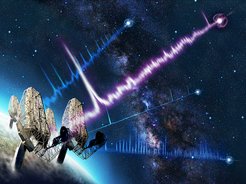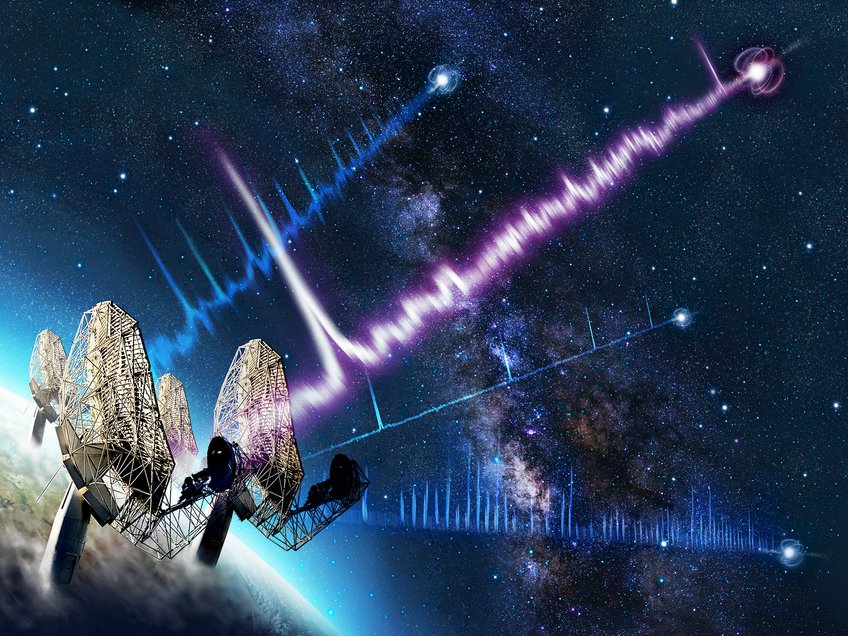A Slowly Rotating Neutron Star
Unusual neutron star spinning every 76 seconds is discovered in stellar graveyard
An international team of scientists including astronomers from the Max Planck Institute for Radio Astronomy in Bonn, Germany, has discovered an unusual radio emitting neutron star, which rotates extremely slowly, completing one rotation every 76 seconds. The team, led by members of the MeerTRAP (More Transients and Pulsars) group at The University of Manchester say it is a unique discovery as it resides in the neutron star graveyard where they do not expect any pulsations at all. The discovery was made using the MeerKAT radio telescope in South Africa.
The results are published in Nature Astronomy on May 30, 2022.

The source was initially found from a single pulse by the ERC-funded MeerTRAP in commensal observations of the field being led by a different team, ThunderKAT. MeerTRAP and ThunderKAT then worked closely together to puzzle out its origin. It was then possible to confirm the pulsations using their 8-second images of the sky and to get an accurate position for the source, enabling detailed and more sensitive follow up observations.
Neutron stars are extremely dense remnants of a supernova explosion of a massive star. Scientists currently know of about 3000 of these in our own Galaxy. However, the new discovery is unlike anything seen so far. The team think it could belong to the theorized class of ultra-long period magnetars with extremely strong magnetic fields.
Dr Manisha Caleb, formerly from The University of Manchester and now at the University of Sydney, who led the research says: “Amazingly we only detect radio emission from this source for 0.5% of its rotation period. This means that it is very fortuitous that the radio beam intersected with the Earth. It is therefore likely that there are many more of these very slowly spinning sources in the Galaxy which has important implications for how neutron stars are born and age.”
“The majority of pulsar surveys do not search for periods this long and so we have no idea how many of these sources there might be. In this case the source was bright enough that we could detect the single pulses with the MeerTRAP instrument at MeerKAT”, she continues.
The newly discovered neutron star is named, PSR J0901-4046, and shows characteristics of pulsars, (ultra-long period) magnetars and even fast radio bursts. While the radio energy exuded suggests a pulsar origin, the pulses with chaotic sub-pulse components, and the polarization of the pulses are reminiscent of magnetars.
While the spin period of PSR J0901−4046 might be consistent with a white dwarf, scientists do not see any multi-wavelength support for this. It is presently unclear how long this source has been emitting in the radio. It was discovered in a well-studied part of the galaxy, but radio surveys don’t usually search for periods this long, or pulses that last more than a few tens of milliseconds.
“The radio emission from this neutron star is unlike any we have ever seen before,” explains Professor Ben Stappers at The University of Manchester and Principal Investigator of the MeerTRAP project. “We get to view it for about 300 milliseconds, which is much longer than for the majority of other radio emitting neutron stars. There seem to be at least 7 different pulse types, some of which show strongly periodic structure, which could be interpreted as seismic vibrations of the neutron star. These pulses might be giving us vital insight into the nature of the emission mechanism for these sources.”
“The sensitivity that MeerKAT provides, combined with the sophisticated searching that was possible with MeerTRAP and an ability to make simultaneous images of the sky made this discovery possible. Even then it took an eagle eye to recognise it for something that was possibly a real source because it was so unusual looking!” says Dr Ian Heywood from the ThunderKAT team and the University of Oxford who collaborated on this study.
Detecting similar sources is observationally challenging, which implies that there may be a larger undetected population waiting to be uncovered. This new discovery adds to the possibility of the existence of a new class of radio transients, the ultra-long period neutron stars, suggesting a possible connection to the evolution of highly magnetized neutron stars, ultra-long period magnetars, and fast radio bursts.
This discovery was made in collaboration with colleagues at the MPIfR at Bonn. The MPIfR had designed, constructed and installed a sophisticated compute facility which allows the synthesized beam of the MeerKAT array to be divided in many hundreds of different pixels that are analyzed in parallel. Dr. Ewan Barr who led this development explains: “Interferometers are great for making images. Searching with them for pulsars or fast transient is not trivial. Our hard- and software has turned MeerKAT into an effective pulsar and transient search machine”. Weiwei Chen, co-author of the study agrees: “It is great to see how our work interfaces with and complements MeerTRAP and how our colleagues make optimal use of it.”
Prof. Michael Kramer, director at MPIfR and head of its “Fundamental Physics in Radio Astronomy” research departments, concludes: “We are very happy to be part of this very exciting discovery. It tells us a lot about the relationship between pulsars and magnetars, and it was possible because MeerTRAP creates synergies between imaging and pulsar searching with MeerKAT brilliantly. I wonder how many more strange pulsars are there out to be discovered!”
------------------------------------------------------------------------------------------
Additional Information
MeerTRAP, funded by the European Research Council (ERC) under the European Union’s Horizon 2020 research and innovation programme (grant agreement No 694745), collaborates closely with the Max-Planck-Institut für Radioastronomie (MPIfR) and makes use of the beamforming and processing infrastructure funded and installed at MeerKAT by the MPIfR and the Max Planck Gesellschaft.
The MeerKAT telescope is operated by the South African Radio Astronomy Observatory, which is a facility of the National Research Foundation, an agency of the Department of Science and Innovation (DSI).
ThunderKAT is co-led by the Universities of Cape Town and Oxford.
Three of the authors, Ewan Barr, Weiwei Chen and Michael Kramer, have an affiliation with the Max Planck Institute for Radio Astronomy.
